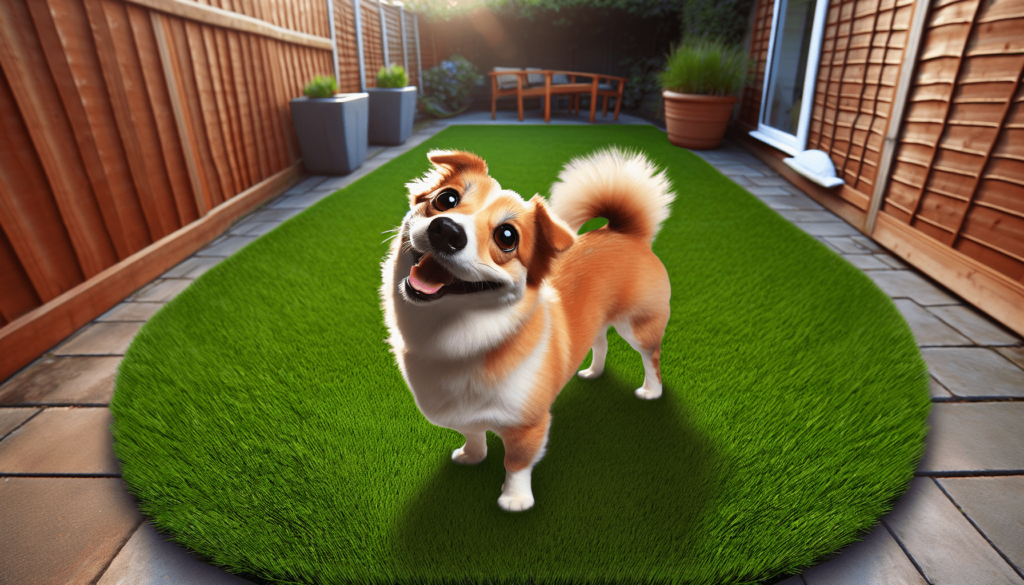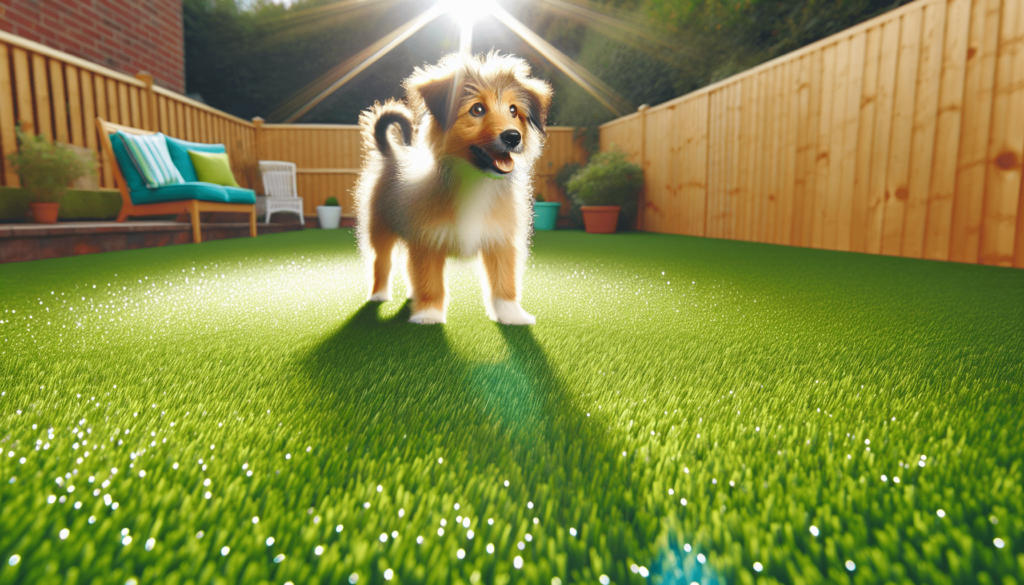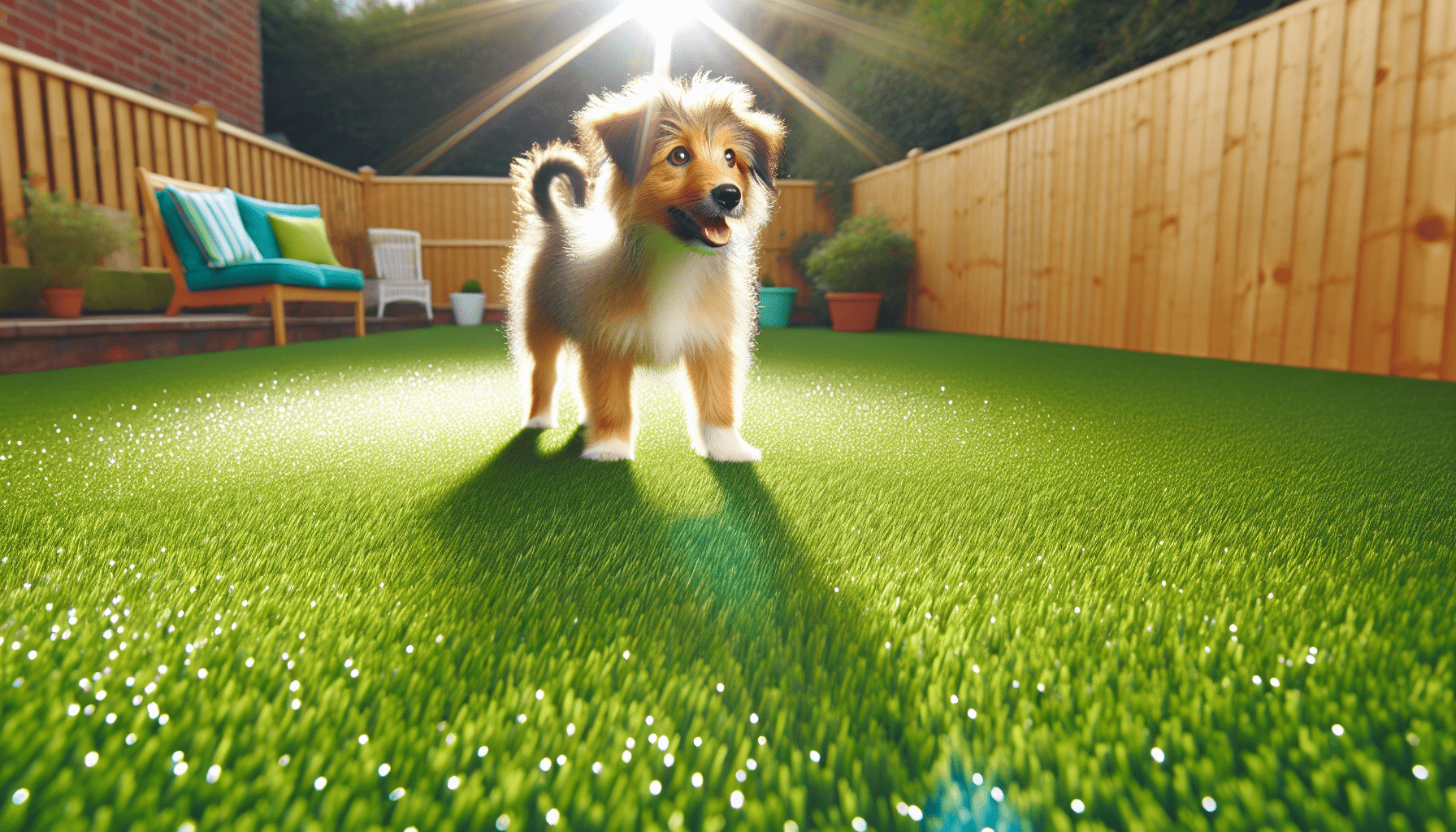As an Amazon Associate, I earn from your qualifying purchases. When you click an affiliate link, we get a small commission at no cost to you.
Embarking on the journey of pet turf was like stepping into a realm where artificial grass held more secrets and surprises than I ever thought possible. In “Navigating the Benefits of Pet Turf” I dive headfirst into the quirky world of synthetic lawns designed for our four-legged friends. Picture this: I’m standing in my backyard, enthusiastically unrolling what looks like a gigantic green carpet, perplexed by its promise to banish muddy paw prints forever. Between my dog’s initial confusion and my own amateur landscaping attempts, I found myself in a comedic whirlwind of peculiar challenges and unexpected delights. Have you ever found yourself staring at your backyard, scratching your head, and wondering if there’s a way to make it look like the lush green lawns you see on TV commercials, minus the mud puddles, bald spots, and frantic digging by your dog Rudy? If so, welcome to my humorous adventure through the wonders of pet turf. Spoiler alert: it’s a wild ride!
Navigating the Benefits of Pet Turf
What on Earth is Pet Turf?
Let’s start with the basics! Pet turf is essentially artificial grass designed with your furry best friends in mind. Imagine if your backyard could look like the 18th green at Augusta National, yet be durable enough to withstand the might of Rudy’s zoomies. That, my friends, is pet turf! It’s designed to be safe and comfortable for pets while being easy to clean and durable for the unpredictable weather elements — or the more predictable ones, like dog pee.
Why Consider Pet Turf?
But why would anyone swap their organic grass for a synthetic one? Well, here are a few reasons that won me over and might just do the same for you:
| Benefit | Traditional Grass | Pet Turf |
|---|---|---|
| Maintenance | Requires regular mowing, watering, and fertilizing | Minimal maintenance (mainly occasional rinsing) |
| Durability | Prone to wear, tear, and digging by pets | Resistant to wear and tear |
| Cleanliness | Potential for muddy paw prints after rain | Clean, mud-free surface |
Minimal Maintenance
Ah, the sweet symphony of dragging out the sprinkler on a hot summer day, only to watch it break two hours later. Pet turf eliminates that hassle. No more mowing, watering, or fertilizing. It’s pretty much like hiring a permanent gardener without the hole in your wallet or the risk of them finding out about your peculiar gnome collection.
Durability Factor
Ever tried to keep traditional grass alive with a dog that firmly believes they’re auditioning for an Olympic digging event? Let’s just say, it’s a losing battle. Pet turf stands up bravely against claws, paws, and the occasional attempts at tunneling to Australia.
Cleaner Environment
Remember those days when Rudy dashed in from the yard, leaving a trail of muddy chaos that would make Indiana Jones proud? Kiss those days goodbye. Pet turf means no more mud, fewer allergens, and a cleaner environment for your indoors and your sanity.
Types of Pet Turf: Options Galore!
Like most things in life, pet turf isn’t a one-size-fits-all situation. There are different types to suit different needs, budgets, and levels of Rudy’s craziness.
Turf Material
Just as there are connoisseurs of fine wines, there are experts in pet turf materials. Here’s a quick breakdown.
| Material Type | Description |
|---|---|
| Polypropylene | Least expensive, less durable |
| Polyethylene | Middle-ground in terms of price and durability |
| Nylon | Most expensive, highly durable, excellent for high-traffic areas |
Polypropylene
The budget-friendly, “don’t look a gift horse in the mouth” kind of turf. Perfect for smaller pets with less yard enthusiasm. If your dog is more of a leisurely napper than a sprinter, this might be your winning ticket.
Polyethylene
Goldilocks would approve of this one – not too cheap, not too expensive. It’s the middle-ground material that balances durability and cost-effectiveness. It can handle a fair amount of pet roughhousing while remaining plush.
Nylon
This is the Rolls Royce of pet turf. It’s heavy-duty, enduring, and perfect for areas that see a lot of action. If Rudy is hosting the neighborhood dog Olympics, nylon is your go-to.
Infill Types
No, infill isn’t a term from a sci-fi novel; it’s what goes between the blades of your turf to help it stand upright and stay resilient. The three primary options are crumb rubber, silica sand, and acrylic-coated sand.
| Infill Type | Pros | Cons |
|---|---|---|
| Crumb Rubber | Great shock absorption | Can retain heat |
| Silica Sand | Does not retain heat, non-toxic | Can harden over time |
| Acrylic-Coated Sand | Non-toxic, does not retain heat, excellent drainage | Most expensive |
Crumb Rubber
Derived from recycled rubber tires, crumb rubber provides a soft, bouncy surface. It’s great for pets prone to launch themselves across the yard, but it can get a tad toasty during summer. Unless you’re training Rudy for hot yoga, consider this point.
Silica Sand
Silica sand won’t turn your yard into a frying pan, and it’s safe for the environment. But beware, it can harden over time like my skeptical demeanor towards getting a Peloton.
Acrylic-Coated Sand
The creme-de-la-creme of infills, acrylic-coated sand is non-toxic, great for drainage, and doesn’t retain heat. It’s perfect for pet turf nirvana but with a price tag to match.

The Installation Journey: Making a Turf-tastic Wonderland
Now, let’s talk about the installation process. If you’re imagining a Bob the Builder scenario, complete with “Can we fix it? Yes, we can!” playing in the background, you’re not far off.
DIY vs. Professional Installation
First decision: Do it yourself or hire the pros? Here’s the lowdown.
| Method | Pros | Cons |
|---|---|---|
| DIY | Cost-saving, satisfying sense of accomplishment | Time-consuming, risk of improper installation |
| Professional | Expert installation, time-efficient, warranty | Higher cost, less personal accomplishment |
DIY Installation
If you’re like me and enjoy the thrill of assembling IKEA furniture without the Allen wrench-induced rage, you might brave the challenge.
Step-by-Step DIY Guide:
- Prepare the Area – Remove existing grass, rocks, and debris.
- Install a Weed Barrier – To prevent the unwelcome reunion with your old nemesis, weeds.
- Add a Base Layer – Typically crushed stones to ensure adequate drainage. You can also use drainage tiles for a firmer base.
- Consider a Shock Pad – A shock pad will add additional cushion to the turf.
- Roll out the Turf – Like unrolling the carpet, but with more sweating.
- Secure the Turf – Stake it down to stop Rudy from turning it into a flying carpet ride.
- Add Infill – Spread your chosen infill evenly and brush the fibers to stand upright.
Professional Installation
Not everyone has a penchant for a weekend DIY marathon, which is why hiring professionals is a popular option. They come equipped with the right tools, expertise, and perhaps even a delightful British accent that makes everything sound better.
Installation Tips
Whichever route you take, here are some tips to remember:
- Measure Twice, Cut Once – And maybe thrice, just to be sure.
- Seamless Seams – Ensure the pieces are joined without obvious seams. No one wants their yard to resemble a jigsaw puzzle.
- Proper Drainage – This isn’t just for aesthetics but also to avoid mini-lakes when nature calls.
Maintenance: Keeping Your Turf in Top Shape
You’ve installed your pet turf, and it looks like a million bucks. Now comes the part where we keep it looking (and smelling) fresh.
Cleaning Routines
Good news – maintaining pet turf isn’t rocket science. Here are some routines that kept my yard spotless and sniff-test approved.
| Routine | Frequency | Action |
|---|---|---|
| Daily | Pick up solid waste | |
| Weekly | Hose down the turf to eliminate odors | |
| Monthly | Brush the fibers to prevent matting, inspect for wear |
Daily Care
Just like with traditional grass, you still need to scoop the poop. A timely removal minimizes odor and bacterial growth.
Weekly Care
A quick rinse with water helps wash away urine and other residues. If Rudy’s hydration habits are Olympic-level, consider using a pet-friendly cleaner occasionally.
Monthly Care
Giving your pet turf a good brush keeps the fibers upright and looking fresh. Think of it as giving Rudy’s favorite napping spot a mini-spa treatment.
Dealing with Odors
Even with the best turf, our fur buddies can still leave a scent. For those times, not everything reeks of roses:
- Baking Soda Solution – A natural deodorizer, mix with water and spray on the turf.
- Vinegar Solution – Another home remedy; mix vinegar with water to neutralize urine odors.
- Commercial Cleaners – Consider specialized turf cleaners or pet odor eliminators for a deep clean. We like ZeoFill PE-51 Pet Odor Eliminator

Real-life Scenarios: Tales from the Turf Front
Of course, no adventure is complete without some real-life anecdotes to sprinkle in. Here are some pet turf tales that keep me chuckling.
Rudy vs. The Squirrel
Rudy has never met a squirrel he didn’t want to chase. Before pet turf, our yard would turn into a mud-streaked battlefield after each encounter. Now, with pet turf, the only evidence of his heroic chases are his adorable out-of-breath huffs and puffs.
The Rogue Inflatable Pool
One inexplicable tradition in our household, every summer, involves setting up an inflatable pool, only for it to inevitably topple over. Previously, this would result in a swamp-like aftermath. With pet turf, the water drains efficiently, and Rudy gets the best of both worlds – spontaneous pool play with no muddy repercussions.
The Food Experiment
If you’ve ever attempted to introduce a new dog food, you know it can be hit or miss. Post new-food diarrhea used to be a nightmare scenario involving greenish lawn “decorations.” Following the pet turf installation, cleanup became exponentially easier, allowing for more experimental dog menus without harrowing clean-ups. Thanks, pet turf!
Final Thoughts: The Verdict on Pet Turf
After journeying through this hilarious, informative, and slightly chaotic tale of pet turf, I’ve realized a few things:
- Balance of Aesthetics and Practicality – Pet turf offers the perfect blend of eye-pleasing green and pet-centric durability. It’s like having your cake and eating it too, minus the crumbs.
- Ease of Maintenance – Less time mowing and more time playing fetch. Win-win in my book.
- Long-term Investment – While the initial cost can be daunting, the long-term benefits make pet turf a worthy investment for pet owners.
In the end, navigating the wonders of pet turf has been nothing short of a humorous adventure filled with muddy mishaps, green triumphs, and one very satisfied pup. So, if you’re staring longingly at your yard, wondering if there’s a better way, take it from me: pet turf is a game-changer, and perhaps, a sanity saver.
Signed, Your Turf-tastic Traveler

